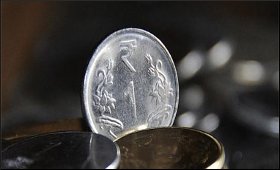|

|
Reforms can help improve sentiments towards rupee
|
|

|
|
| Top Stories |
 |
|
|
|
Vatsal Srivastava | 02 Jul, 2013
In the financial markets, every trader has his own style, methodology and a favourite list of fundamental and technical indicators which is developed over time to be consistently profitable. But there is one golden rule subject to absolutely no modification: “You don’t fight the Fed”.
This golden rule must be kept in mind while taking a directional call on the dollar-rupee pair from the current levels of about 59.5. Most currency analysts are waiting for another sharp move to the upside in the USD-INR pair to levels of about 63-65, before getting tactically short (expecting the rupee to appreciate against the dollar) from those levels.
For the short term, this seems like the ideal strategy to deploy as currency speculators have positioned themselves for continued dollar strength and positive data coming out of the US which would support the beginning of the end of the unconventional monetary policy era.
The fundamentals of the Indian economy, although weak, have not changed since Ben Bernanke announced that the Federal Reserve might consider “tapering” off its quantitative easing (QE) programme as soon as September this year.
The volatile move to the upside from 56 to 60.7 since the beginning of June was solely based on the anticipation of less dovish comments coming out of the Federal Open Market Committee (FOMC).
This coincided with the dollar index, a weighted index measuring the performance of the US dollar against the euro, British pound, yen, Swiss franc, Swedish krona and the Canadian dollar rallying from 80.5 to 83.5. Emerging market (EM) currencies were hit more severely with the Mexican peso, Brazilian real, Turkish lira and the South African rand depreciating against the dollar by more than 7 percent each over the past one month.
The markets are currently pricing in the fact that the Federal Reserve will moderately start reducing its monthly purchases of bonds and mortgage backed securities of $85 billion and completely end the purchases by mid- 2014. In simple terms, what this really means is that the sick patient (US economy) who was on life support (QE) is getting better as per the doctors (Fed’s) expectations and over the next 12 months, the probability that the patient would not need the life support is very high.
Further, since December 2012, the Federal Reserve has tied the evolution of its QE programme to a key macroeconomic variable - unemployment. In a press conference, Bernanke said that when the asset purchases ultimately come to an end, the unemployment rate would be in the vicinity of 7 percent.
On the back of better than expected non-farm payrolls data and jobless claims for the past couple of months, the most conservative estimate is that the unemployment rate would fall to 7.1 percent by May 2014.
Bond yields on 10-year US treasuries have risen above 2.5 percent in anticipation of higher future real interest rates marking the end of the zero interest rate policy (ZIRP) regime. In the currency market, the rising yields have led to the unwinding of the dollar "carry trade". A carry trade is when an investor borrows a currency with low interest rates, like the US, and uses it to buy assets in another currency with higher interest rates such as Indian Rupee and other EM currencies.
For the next couple of months, one would be betting against the global trend of dollar strength and a strong US economic recovery if one were to position himself for the rupee staging a comeback.
If the dollar index rallies up to the 90-95 levels by year end, even RBI intervention may not be able to abate the rupee's fall. Further rate cuts by the RBI, which are INR positive as they lead to portfolio inflows in the medium term, are also not on the radar as inflation remains stubbornly high.
But the sentiment towards the rupee can be improved by action from New Delhi which could possibly include further liberalisation of the capital account, debt market (DM) reform and relaxation of foreign direct investment limits - initiatives that would encourage capital inflows in a time where liquidity is moving back to the DMs, most notably in the United States.
|
|
|
| |
|
|
|
|
|
|
|
|
|
|
|
|
|
|
| |
| Customs Exchange Rates |
| Currency |
Import |
Export |
US Dollar
|
84.35
|
82.60 |
UK Pound
|
106.35
|
102.90 |
Euro
|
92.50
|
89.35 |
| Japanese
Yen |
55.05 |
53.40 |
| As on 12 Oct, 2024 |
|
|
| Daily Poll |
 |
 |
| Do you think Indian businesses will be negatively affected by Trump's America First Policy? |
|
|
|
|
|
| Commented Stories |
 |
|
|
|
|
|
| |
|